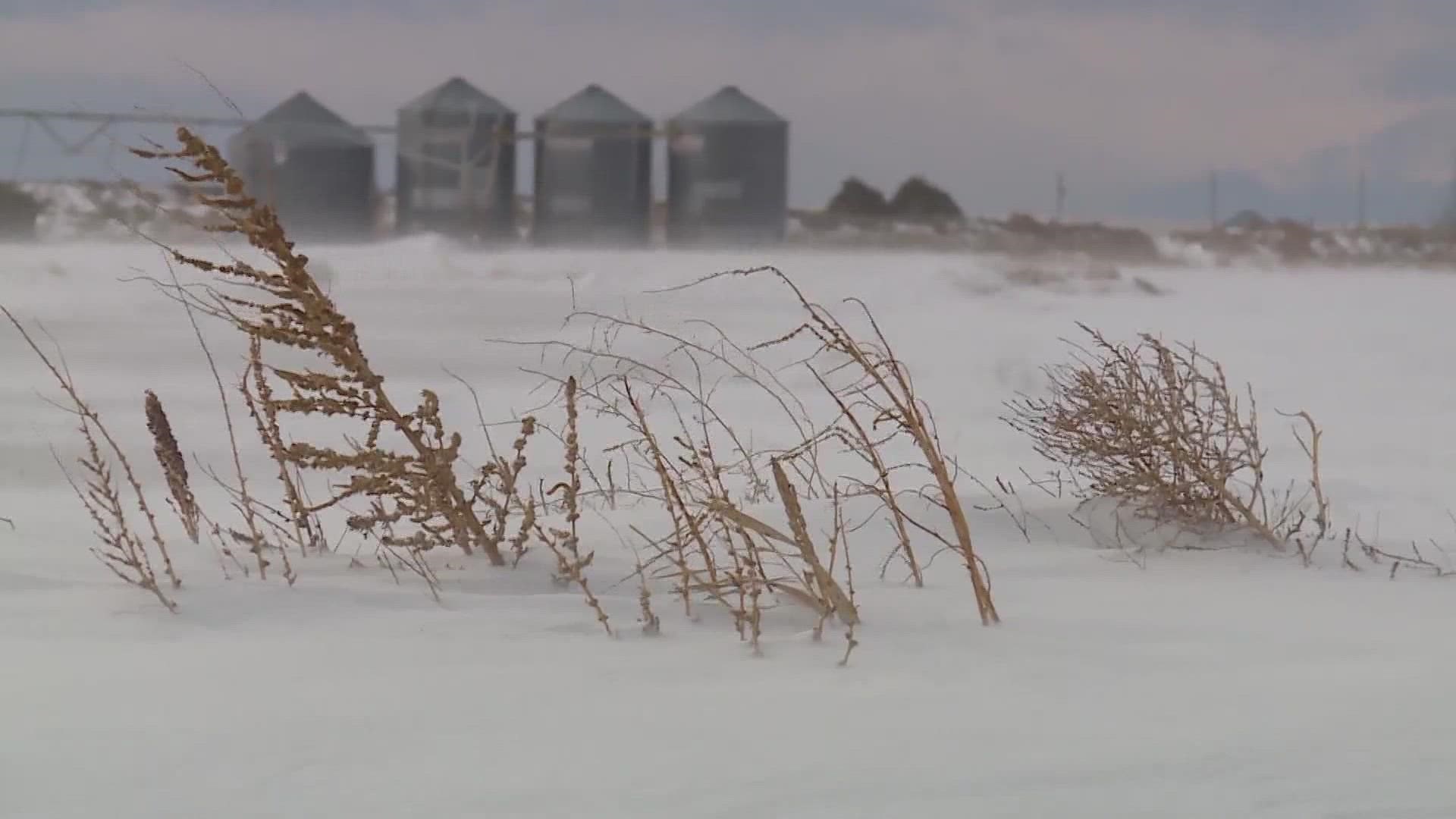BURLINGTON, Colo. — Farmers and ranchers on the Eastern Plains of Colorado will rarely turn down precipitation, but a blizzard isn't as helpful as you might think, especially a December blizzard.
But first, the good. The blizzard hit the most drought-stricken portion of Colorado. Level 2 Severe drought conditions cover the entire Eastern Plains, and Sedgwick and Phillips counties in the northeast corner even have Level 3 Extreme drought and the highest level of drought, Exceptional.
A snowfall analysis by the National Weather Service shows that 3 to 12 inches of snow fell across the northeast plains. Citizen reports of water content ranged from 0.25 inches to 0.86 inches.
That's only about as much rain as falls during a single thunderstorm in Colorado.
But a big benefit with the snow is that it covers a huge area. The bulk of Tuesday’s blizzard hit 12 counties totaling about 20,000 square miles. A big thunderstorm only covers about 1,000 square miles with rain. So Tuesday’s blizzard equaled about 20 thunderstorms across the plains.
That will be able to reduce the drought conditions some. It may not eliminate the area of Exceptional conditions, but we should see at least some reduction.
"We have been in such a drought over the last two growing seasons, and that has depleted our subsoil moisture," said agronomist Ron Meyer with the Colorado State University Extension. "This snow will help the top 3 to 5 inches of the soil, but there's absolutely no moisture below 6 inches deep, and that's a problem."
He said it will take a series of wet months to replenish the subsoil.
If only it were March
Prairie blizzards are not unusual in December, but they are far more common in the spring months of March and April.
And those spring blizzards can bring two to three times more moisture than this December storm just delivered. The March 2021 blizzard brought between 1 inch and 3.5 inches of precipitation.
The crops
Any moisture is good moisture, but Tuesday's blizzard won't help all agriculture equally.
Many Colorado farmers planted their winter wheat crop in September and October, and it's grown about an inch or two before going into a semi-dormant acclimation for the winter.
Meyer said the problem with a blizzard in December is not just that the snow is drier, but it's also lighter. That means the wind can have more of an effect.
“It blows the snow off those plants and subjects them to another stress, and the last thing they need in the wintertime is another stress,” Meyer said.
He said it's really the spring months, when the wheat resumes growth, that the plants need the moisture the most.
The extreme cold temperatures can also hurt the wheat.
"The varieties that we are growing these days are more cold-tolerant, so they are accustomed to some extreme temperatures," he said. "But I do expect to see a little isolated plant damage from this storm. Mostly on hilltops where the snow has been stripped away the most, along with the cold."
Meyer also said the soil temperatures can rebound a little quicker after a spring storm, which really helps the wheat. This week, the lows will stay in the single digits with highs in the 20s and 30s for several more days after the storm.
Spring snow is also heavier, so more of it sticks to the fields.
While the wind might blow the snow away from the winter wheat crops, it does benefit harvested fields that are vacant of a cash crop over the winter.
"Most of the growers here practice reduced tillage, which leaves some stubble from harvested crops in the fields," he said. "And that stubble will capture a lot of the snow and hold it in place. That will be a great benefit for those fields when it's time for spring planting."
The cattle
The long-lasting cold of a blizzard in December is also a little rougher on the cattle compared to a spring blizzard.
"Cows are pretty tough, but they need a lot of calories to survive a blizzard like this," Meyer said. "The snow will cover up some of their food source, so ranchers will have to supplement their feed a little bit for a few days."
The temperature rebound after a spring blizzard can help the cattle just like it helps the plants. It also helps that the snow melts away faster in the spring.
Meyer said he hasn't heard of any cattle deaths as a result of this blizzard, and he doesn't expect that will be the case since it was a relatively quick storm, and the drier snow got spread evenly in the high winds.
A December storm also means that ranchers didn't have to worry about calves like they do during a spring blizzard.
“One of the reasons that no one calves in December is because of weather like this," he said. "Those little calves with cold and snow, they just don’t do well.”
SUGGESTED VIDEOS: Colorado Climate

